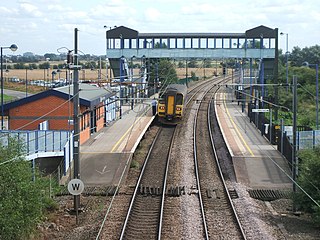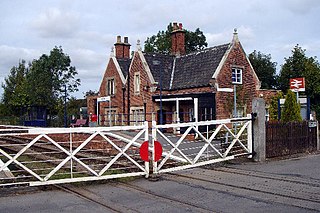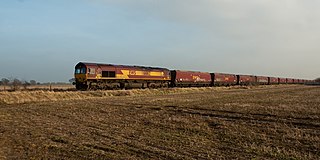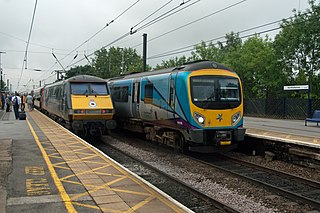
The East Coast Main Line (ECML) is a 393-mile long (632 km) electrified railway between its southern terminus at London King's Cross station and Edinburgh Waverley via Peterborough, Doncaster, York, Darlington, Durham and Newcastle. The line is a key transport artery on the eastern side of Great Britain running broadly parallel to the A1 road. The main line acts as a 'spine' for several diverging branches, serving destinations such as Cambridge, Leeds, Hull, Sunderland and Lincoln, all with direct services to London. In addition, a few ECML services extend beyond Edinburgh to serve Glasgow Central, although the principal London-Glasgow route is the West Coast Main Line (WCML).

The Sheffield–Lincoln line is a railway line in England. It runs from Sheffield to Lincoln via Worksop, Retford and Gainsborough Lea Road. The route comprises the main line of the former Manchester, Sheffield and Lincolnshire Railway (MS&LR), to Gainsborough Trent Junction, where it then follows the former Great Northern and Great Eastern Joint Railway (GNGEJR) to Lincoln Central. The former MS&LR main line continues from Trent Junction to Wrawby Junction, Barnetby, much of it now single line, where it then runs to Cleethorpes. In 2023, the Department for Transport announced that a new station will be opened on the line. Waverley station will be located between Darnall and Woodhouse.

Adwick railway station serves the communities of Adwick le Street and Carcroft, in the Metropolitan Borough of Doncaster, South Yorkshire, England. Located on the line linking Leeds to Doncaster via Wakefield, immediately south-east of the point where it passes beneath Church Lane, the present station is the second to serve Adwick: the first, the main building of which still stands, lay on the other side of the present road bridge.

The Barton line is a railway line in North and North East Lincolnshire, England. It runs from Barton-upon-Humber south east to Cleethorpes and was designated by the Department for Transport as a community rail line in February 2007. Barton station is near to the Humber Bridge. It is situated on the south bank of the Humber Estuary.

Goxhill railway station serves the village of Goxhill in North Lincolnshire, England. It was built by the Great Grimsby and Sheffield Junction Railway in 1848. The station is on the Barton Line 17 miles (27 km) north west of Cleethorpes and all trains serving it are operated by East Midlands Railway.

The Askern branch line is a railway line which runs in North, South and West Yorkshire in England. The stretch of track runs from Shaftholme Junction north of Doncaster, via Askern, Norton and Womersley to Knottingley, where it joins the Pontefract Line.

Doncaster PSB is a signalling centre on the East Coast Main Line (ECML) railway in the United Kingdom, principally covering the line from London to Edinburgh but also encompassing other lines diverging and converging to the ECML. The signal box celebrated its 25th birthday in 2006.

Ludborough is a heritage railway station in Ludborough, Lincolnshire, England, which is the base of the Lincolnshire Wolds Railway. The station, which was previously part of the East Lincolnshire Railway, closed in 1961 to passengers and 1964 to freight, but was taken over by the preservation society in 1984. The first trains from the station to North Thoresby, to the north, ran in August 2009, the first for 47 years. There are proposals to extend the line further in both directions towards Holton-le-Clay and Louth.

Holton Village Halt was a railway halt on the East Lincolnshire Railway which served the village of Holton-le-Clay in Lincolnshire between 1905 and 1961. The station, which opened as part of a new motor train service between Grimsby and Louth, was the second station to serve the village after Holton-le-Clay and Tetney situated further to the south. The line through Holton-le-Clay remained open for freight until December 1980.
Weelsby Road Halt was a railway halt on the East Lincolnshire Railway which served the Weelsby Road area of eastern Grimsby in Lincolnshire between 1905 and 1940. The station was opened as part of a new motor train service between Grimsby and Louth. It was the site of major works in 1933 when a plate girder bridge was constructed to replace a level crossing, enabling road traffic to pass underneath through a subway. The station closed in 1952 following a period of temporary closure during the Second World War. The line through Weelsby remained open for freight until December 1980. The trackbed was later reused by Humberside County Council to construct the A16 Peaks Parkway which now runs through the site. Building of the road put an end to the aspirations of the Great Northern and East Lincolnshire Railway plc to reopen the line as a heritage railway.
Hainton Street Halt was a railway halt on the East Lincolnshire Railway which served the Welholme Road area of Grimsby in Lincolnshire between 1905 and 1961. The station was opened as part of a new motor train service between Grimsby and Louth. The station briefly closed in 1939 as a Second World War economy measure, but reopened in 1940. The line through Hainton Street remained open for freight until December 1980. The trackbed was later reused by Humberside County Council to construct the A16 Peaks Parkway which now runs through the site. Building of the road put an end to the aspirations of the Great Northern and East Lincolnshire Railway plc to reopen the line as a heritage railway.

Dukeries Junction, originally Tuxford Exchange, was a railway station near Tuxford, Nottinghamshire, England. The station opened in 1897 and closed in 1950. It was located at the bridge where the Lancashire, Derbyshire and East Coast Railway crossed over the East Coast Main Line (ECML), with sets of platforms on both lines. The high-level location is now part of the High Marnham Test Track.

The South Humberside Main Line runs from Doncaster on the East Coast Main Line to Thorne where it diverges from the Sheffield to Hull Line. It then runs eastwards to Scunthorpe and the Humber ports of Immingham and Grimsby, with the coastal resort of Cleethorpes as terminus.
Marsh Road Level Crossing electric railway station was situated at the seventh of eight passing loops on the otherwise single track central "country" section of the inter-urban Grimsby and Immingham Electric Railway when travelling from Corporation Bridge, Grimsby to Immingham Dock.
No. 6 Passing Place electric railway station was situated at the sixth of eight passing loops on the otherwise single track central "country" section of the inter-urban Grimsby and Immingham Electric Railway when travelling from Corporation Bridge, Grimsby to Immingham Dock.
Great Coates Level Crossing electric railway station was situated at the third of eight passing loops on the otherwise single track central "country" section of the inter-urban Grimsby and Immingham Electric Railway when travelling from Corporation Bridge, Grimsby to Immingham Dock.

Ulceby Aerodrome Platform railway station was situated 74 chains (1.5 km) northeast of Ulceby North Junction between Ulceby and the village of South Killingholme, Lincolnshire, England. It was opened by LNER to serve the Second World War airfield RAF North Killingholme, whose southern perimeter lay a short distance to the north.

The network of railways in Northallerton, North Yorkshire, England, was constructed by three companies whose lines through the town were built between 1841 and 1852. They were all amalgamated into the North Eastern Railway (NER) which in turn was subsumed into the London and North Eastern Railway in 1923 and British Rail in 1948. British Rail closed two lines, the Wensleydale line in 1954 and a section of the Leeds Northern Railway to Harrogate in 1969. The Wensleydale line was retained as a freight branch and resurrected as a heritage railway in 2003 but the line to Harrogate closed completely. Despite closures and rationalisation, the station still is at a major junction on the East Coast Main Line.

The York and Doncaster branch was a railway line that opened in 1871 connecting Doncaster with York via Selby in Yorkshire, England. This line later became part of the East Coast Main Line (ECML) and was the route that express trains took between London King's Cross, the north of England and Scotland. It was opened by the North Eastern Railway (NER) between York and Shaftholme Junction, some 4.5 miles (7.2 km) north of Doncaster railway station. Between its opening in 1871 and the grouping in 1923, the line was used by both the NER, and the Great Northern Railway (GNR). All of the intermediate local stations that had opened with the line in 1871 closed down in the 1950s and 1960s leaving just Selby open between the town of Doncaster and the city of York.

The North Doncaster Chord is a railway connection (chord) between the freight only lines between Hatfield & Stainforth railway station and the Askern branch line, in South Yorkshire, England. The line was built to allow heavy freight trains, mostly from the Port of Immingham, to access the power stations in the lower Aire Valley without the need for them to use the East Coast Main Line (ECML) and creating slower line speeds for faster passenger trains. The chord meant the creation of 2 miles (3.2 km) of new railway and the building of Shaftholme Viaduct, which straddles the East Coast Main Line.















